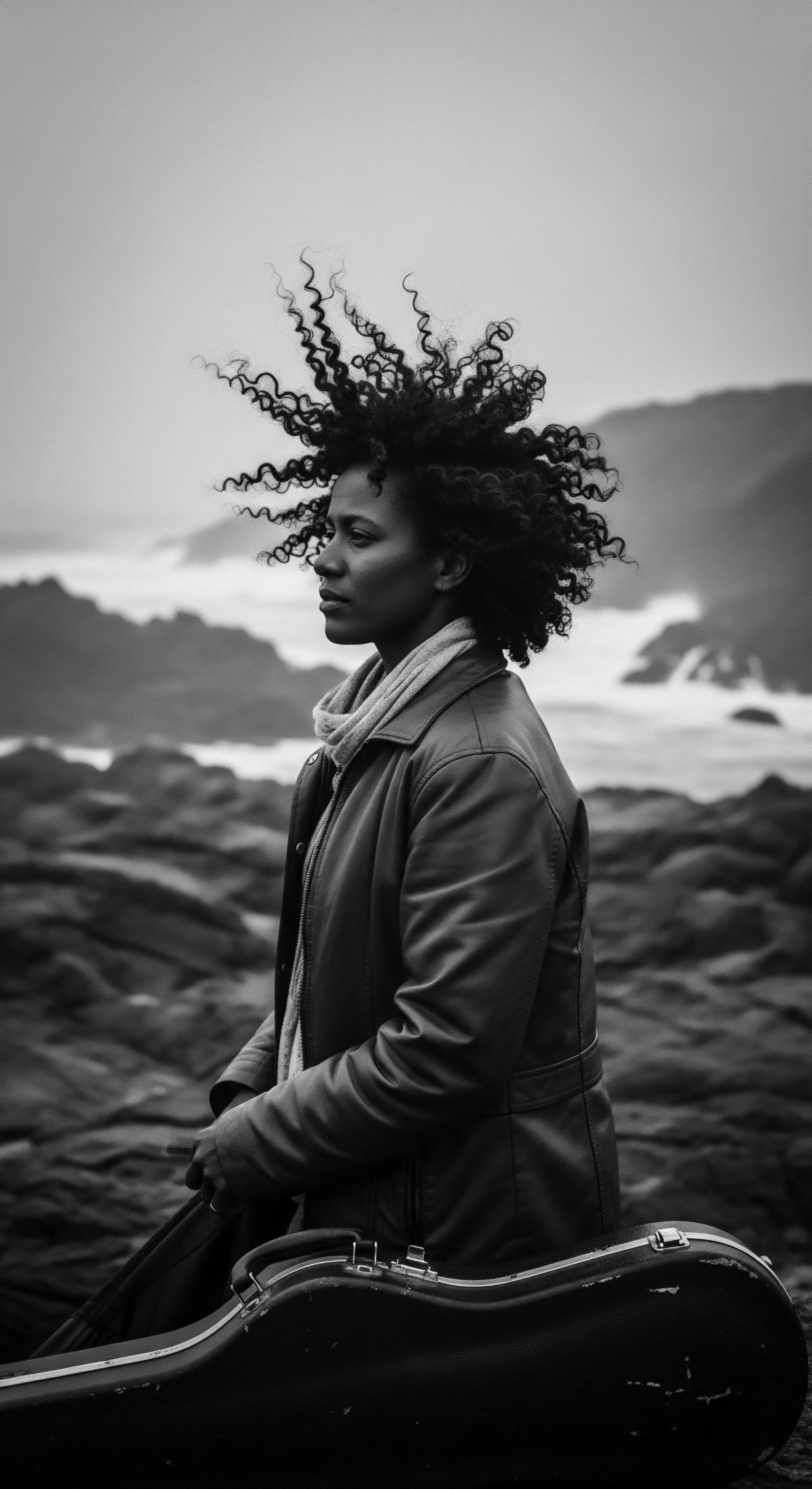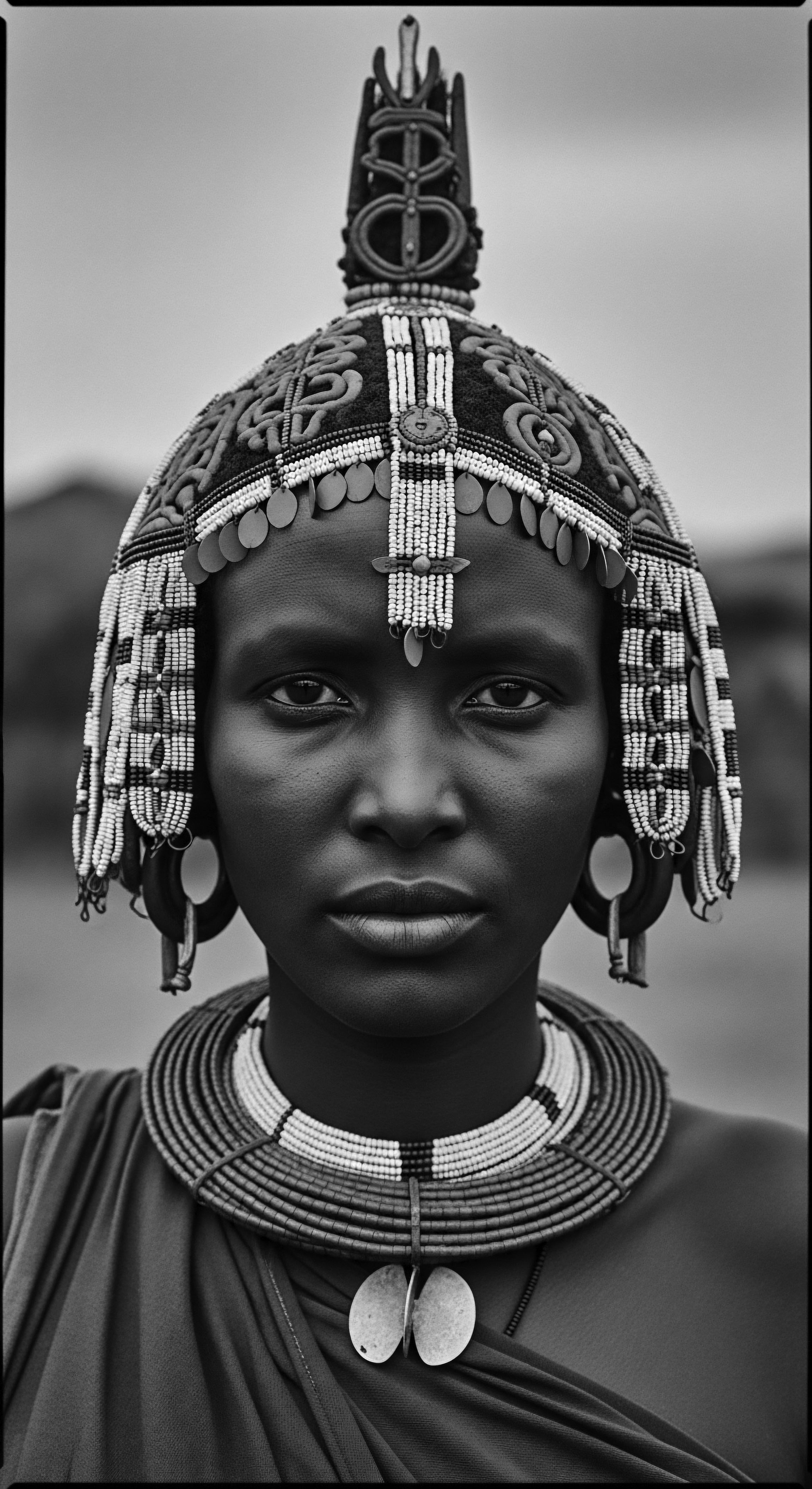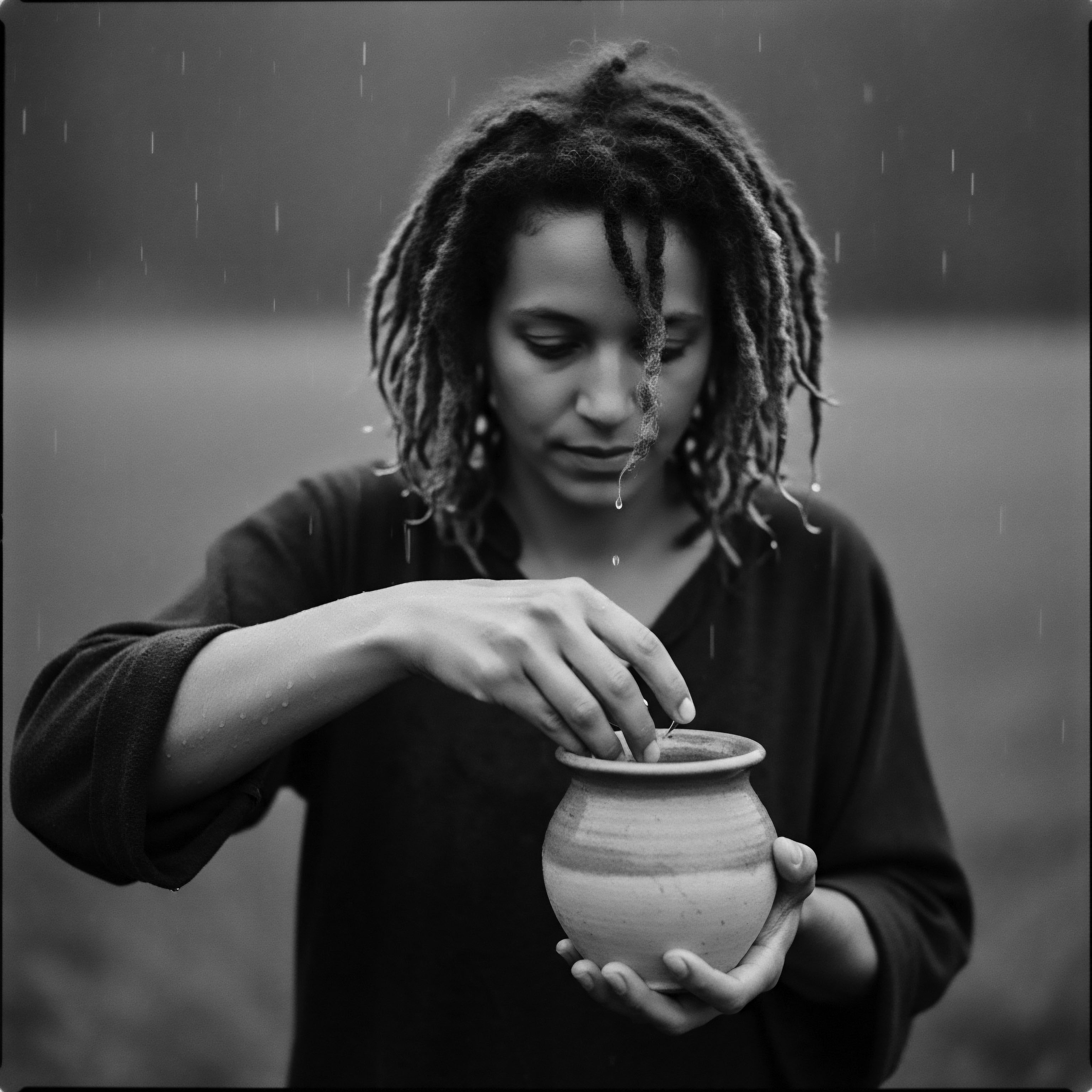
Roots
The very strands of textured hair carry echoes of ancestral wisdom, a living archive whispered across generations. To truly comprehend how traditional oiling practices sustained this profound heritage , one must first stand at the wellspring of its existence ❉ the hair itself. This physical aspect, with its unique helical structure and inherent qualities, shaped the ancient methods of care, long before the lexicon of modern science existed. In arid climates, or in lands rich with sun, the need to protect and nourish the hair was not a cosmetic whim; it was a daily imperative for well-being.

Hair Anatomy and Its Ancestral Resonance
Consider the singular architecture of textured hair. Unlike its smoother counterparts, each strand grows in a distinctive elliptical or flattened cross-section, forming a tight coil, a series of twists, or a compact curl. This structural characteristic, while offering splendid volume and protective styling capabilities, also presents inherent challenges.
The bends and curves along the hair shaft create natural points where the cuticle layers, the outer protective scales of the hair, can lift, making the hair more porous. This increased porosity means moisture can escape more readily, leading to dryness, a perennial concern for those with highly coiled hair.
From this fundamental biological reality, ancient communities devised ingenious solutions. They looked to the earth, to the trees, and to the bounty of local flora for sustenance. The use of oils and butters was a direct response to the hair’s intrinsic need for moisture retention and lubrication.
This practice was not haphazard; it developed through centuries of observation, passed down through the skillful hands of mothers, grandmothers, and community elders. These historical practices were, in essence, early forms of applied science, responding to hair physiology with available resources.
Traditional oiling responded directly to the inherent structure of textured hair, mitigating its propensity for dryness and honoring its natural strength.

Understanding Hair’s Protective Layers
The outer layer of the hair, the cuticle, acts as a shield. When healthy and smooth, it helps keep moisture within the hair shaft. For coiled hair, the cuticle is naturally more raised at the points of curvature, leaving the inner cortex somewhat more exposed to environmental elements and moisture loss. Oils, with their various fatty acid profiles, were historically selected for their ability to sit upon the hair or penetrate its layers, effectively sealing these cuticles and creating a barrier against desiccation.
This elemental understanding of protection, though articulated differently in ancient times, mirrors modern scientific insights. The efficacy of traditional oils lay in their lipophilic nature, their affinity for the natural lipids of the hair, enabling them to supplement what the hair naturally produced or lost. The choice of specific oils often reflected regional availability and particular benefits perceived over generations of use.

The Language of Textured Hair Care
The lexicon surrounding textured hair has evolved, but its roots remain intertwined with ancestral practices. Terms that describe hair types, conditions, and care methods often stem from observations made over centuries of practical engagement. The very act of oiling was integrated into the language of daily life, indicating not only physical care but cultural continuity.
The earliest descriptions of hair, its forms, and its needs, shaped the communal conversations about beauty, health, and belonging. This historical vocabulary, though sometimes lost or altered, forms a part of the hair’s enduring heritage .
The historical journey of textured hair and its care began with an intimate dialogue between human needs and nature’s provisions. Oiling stands as a central voice in this dialogue, a testament to ancient wisdom recognizing and responding to the unique characteristics of coiled strands, safeguarding their strength and vitality for future generations.

Ritual
Beyond the purely functional, traditional oiling practices for textured hair ascended to the realm of profound ritual, intertwining with the very fabric of community and identity. These were not isolated acts; they were communal expressions, moments of profound connection that served to transmit not only practical care methods but also the deeper cultural values and heritage embedded within hair itself. This section delves into the intricate choreography of these customs, the tools employed, and the transformative power they held.

The Sacred Space of Hair Care
In many African societies, hair care unfolded as a collective endeavor, often performed by women for women, fostering an environment of shared stories, laughter, and wisdom. The act of oiling, combing, and styling became a conduit for intergenerational bonding, a time when ancestral knowledge passed from elder to youth, hand to hand, whisper to ear. This communal aspect was especially vital in maintaining morale among enslaved populations, where the simple act of braiding or oiling hair helped recreate a sense of family and cultural continuity amidst brutal dehumanization. During the transatlantic slave trade, enslaved Africans, stripped of their traditional tools, improvised, using readily available cooking oil, animal fats, and butter to maintain their hair, transforming these basic items into tools of survival and cultural preservation.
These gatherings were living lessons in patience, skill, and reverence for one’s appearance. Hair was understood as a direct link to the spiritual realm, the most elevated part of the body, a channel for communication with deities and ancestors. Therefore, its care was imbued with spiritual weight. The oil applied was not merely a cosmetic aid; it was a sacred balm, fortifying both the physical strands and the spiritual connection they represented.
Hair care rituals, particularly oiling, transformed into powerful expressions of community, ancestral knowledge, and profound spiritual connection.

Tools and Adornments
The instruments of care, though simple, held deep significance. Before mass-produced combs, natural materials like wood, bone, or even improvised items became essential. These tools, often crafted within the community, were extensions of the hands that performed the rituals, bearing the marks of time and repeated use.
Oils themselves varied by region and availability. In West Africa, the prominence of Shea Butter (Vitellaria paradoxa) stands as a profound example, a staple for centuries, used not only for hair but for skin protection, cooking, and medicinal purposes. Its extraction, often a labor-intensive process performed by women, created communal economies alongside its personal care application. Similarly, Palm Oil, derived from the oil palm tree (Elaeis guineensis), held a central position in West African societies for millennia, valued for culinary uses and also for hair and skin care.
Other botanical treasures included Coconut Oil in coastal regions and the Caribbean, or Jojoba Oil, whose functional properties resonated with Black beauty traditions emphasizing nourishment. These natural emollients were often infused with herbs, clays, or plant extracts, adding further layers of traditional knowledge and local efficacy. For example, the Himba people of Namibia traditionally use Otjize, a mixture of butterfat and ochre, to coat their hair and skin, providing both cultural symbolism and practical protection from the sun and insects. This shows how deep-rooted resourcefulness and a bond with the land underpinned many of these traditional practices.

Transforming Through Care
Beyond simple application, oiling was often integrated into intricate styling processes. Protective styles like braids, twists, and cornrows, with their roots firmly in African traditions, were prepared and maintained with generous applications of oil or butter. These styles protected the hair from environmental elements, prevented tangling, and promoted length retention. The oil provided the lubrication necessary for the fingers to glide through the strands, minimizing friction and breakage during styling.
The physical transformation of hair through these rituals was mirrored by a psychological one. The diligent care, the communal experience, and the connection to a rich past instilled a sense of pride and self-worth. In a world that often sought to diminish their humanity, the conscious attention to their hair became an act of self-affirmation, a visible declaration of heritage and identity. The art and science of traditional hair oiling, thus, transcended mere beauty upkeep; it became a living narrative of cultural survival and enduring spirit.

Relay
The journey of traditional oiling, from ancient origins to its ongoing relevance, speaks to a profound relay of knowledge and resilience. This section delves into the intricate interplay of historical continuity, scientific validation, and the enduring cultural impact of these practices, demonstrating how they sustained textured hair heritage even through periods of immense disruption.

Echoes of Ancient Wisdom in Modern Science
The practices of traditional oiling, honed over millennia, reveal an intuitive understanding of hair biology that modern science now often validates. For instance, the use of coconut oil, prevalent in parts of Africa and the Caribbean, is now recognized for its unique ability to penetrate the hair shaft, reducing protein loss and fortifying strands from within. This capacity to permeate the hair’s cortex, rather than just coat the surface, helps minimize the damage caused by washing and styling. The heritage of its consistent application reveals a deep, experiential grasp of its protective qualities.
Similarly, the widespread reliance on shea butter across West Africa finds scientific backing in its rich composition of fatty acids and vitamins A and E, which provide moisturizing, anti-inflammatory, and protective benefits. These compounds help to create a barrier, sealing moisture into the hair, which is crucial for textured hair types prone to dryness. The consistent use of such natural emollients, passed down through generations, effectively addressed the hair’s inherent needs long before laboratories could isolate and explain these chemical properties.
| Traditional Oil/Butter Shea Butter |
| Historical/Cultural Significance to Hair Heritage A staple in West African communities for centuries; used for moisture, sun protection, communal ceremonies. |
| Modern Scientific Link to Hair Care Rich in vitamins A, E, and fatty acids; moisturizes, reduces inflammation, offers UV protection, helps hair retain moisture. |
| Traditional Oil/Butter Palm Kernel Oil (African Batana Oil) |
| Historical/Cultural Significance to Hair Heritage Used for millennia in West Africa for hair, skin, and culinary purposes; associated with stronger, thicker hair. |
| Modern Scientific Link to Hair Care High in lauric acid; provides antimicrobial properties, strengthens hair, reduces dandruff, aids absorption of treatments. |
| Traditional Oil/Butter Coconut Oil |
| Historical/Cultural Significance to Hair Heritage Prominent in tropical African and Caribbean regions; valued for protective, conditioning properties. |
| Modern Scientific Link to Hair Care Penetrates hair shaft, reducing protein loss and fortifying strands; helps prevent damage from washing and styling. |
| Traditional Oil/Butter These ancestral insights into natural resources continue to inform and validate contemporary hair care approaches, preserving a living heritage. |

How Did Hair Care Endure During Forced Migration?
The tragic history of forced migration, particularly the transatlantic slave trade, presented immense challenges to the continuity of textured hair care practices. Enslaved Africans were often forcibly shorn of their hair upon arrival, a deliberate act designed to strip them of identity and cultural connection. Despite these brutal efforts at cultural erasure, the deep-seated knowledge of hair care, including oiling, persevered through remarkable acts of adaptation and quiet resistance.
Deprived of traditional tools and indigenous ingredients, enslaved individuals employed whatever was accessible on plantations, such as cooking oil, animal fats, and butter, to moisturize and protect their hair. This resourcefulness speaks to the profound significance hair held as a connection to their origins and an assertion of self. Hair became a canvas for silent communication and defiance.
It is speculated that intricate cornrow patterns sometimes served as maps for escape routes, with seeds even braided into the hair for sustenance after escape. This adaptation of traditional techniques under duress exemplifies the enduring power of hair heritage as a symbol of survival and resistance.
In the face of oppression, the ingenious adaptation of traditional oiling and styling practices became a powerful symbol of cultural survival and resistance for enslaved communities.

Maintaining Intergenerational Knowledge
The survival of traditional oiling methods depended heavily on oral tradition and hands-on instruction. Knowledge was not written in texts; it was embodied in communal rituals and passed directly from elder to child. This method of transmission ensured that the nuances of application, the specific benefits of various oils for different hair conditions, and the cultural meanings remained intact across generations. Even as external pressures advocated for the straightening of textured hair, particularly during the 19th and 20th centuries, the practice of oiling remained a private, domestic act of care within Black and mixed-race households, preserving a quiet but persistent link to ancestral ways.
The contemporary resurgence of the natural hair movement in the 21st century has brought renewed attention to these traditional practices. There is a deliberate turning back to ancestral knowledge, with individuals seeking out authentic oils and techniques, often informed by ethnographic studies and historical accounts. This movement represents a conscious continuation of the relay, not just of products, but of a philosophy of self-acceptance and reverence for one’s heritage through hair. The enduring presence of oiling in modern hair care regimens is a testament to its efficacy and its profound cultural staying power.

Reflection
To hold a strand of textured hair is to hold a fragment of time, a living testament to journeys spanning continents and centuries. Traditional oiling, in its varied forms and applications, has not merely served as a practical means of hair care; it has been a keeper of ancestral memory, a silent narrator of resilience, and a consistent thread weaving through the grand tapestry of textured hair heritage . From the protective wisdom passed down in sun-drenched African villages to the defiant acts of self-preservation amidst enslavement, and onward to the contemporary embracing of natural beauty, the application of oils has remained a profound act of self-love and cultural affirmation.
The meticulous attention paid to each coil and curve, nourished by the earth’s precious yields, speaks to a deep respect for the physical self and its connection to a collective past. It is a dialogue with our ancestors, a reaffirmation of the practices that safeguarded not only the hair but the spirit of those who came before us. This enduring practice helps us find wellness not just in the visible health of our hair, but in the holistic understanding of self, rooted firmly in wisdom that transcends fleeting trends. The story of oiling is a luminous chapter in the living library of Roothea, reminding us that care, truly understood, always begins with reverence for where we come from.

References
- Cécred. (2025, April 15). Understanding Hair Oiling ❉ History, Benefits & More.
- BeautyMatter. (2025, February 4). The Untold Story of Jojoba Oil in Black Beauty.
- The Afro Hair & Skin Co. (2023, November 20). Embracing Tradition ❉ The Lost Art of African Hair Threading.
- Salford Students’ Union. (2024, October 29). The Remarkable History Behind Black Hairstyles.
- New Directions Aromatics. (2017, October 5). Red Palm Oil & Palm Kernel Oil – For Hair Care & Skin Care.
- Ciafe. (2023, January 31). Discovering the Origins of Shea Butter.
- KhalidaNaturals. (n.d.). Pure West African Batana Oil (Palm Kernel Oil).
- Afriklens. (2024, November 1). African Hairstyles ❉ Cultural Significance and Legacy.
- MyHairSmart. (2025, March 17). Haircare Rituals Around the World ❉ Exploring Global Traditions.
- American Bar Association. (2024, November 4). My Crown, My Glory ❉ What Advocates Should Know about the Significance of Hair to Black Youth.
- Newsweek. (2022, August 24). Everything You Need To Know About The Ancient Art Of Hair Oiling.
- BLAM UK CIC. (2022, September 15). The History of Black Hair.
- ADJOAA. (2024, February 8). The Recent History of Hair in Afro-American Culture.
- AramcoWorld. (2017, January 1). Cracking Coconut’s History.
- PsychoHairapy. (2024, December 18). Our Hair ROOTS ❉ Incorporating our Black Family Hair Traditions and Routines as a Coping Technique to Increase Positive Mental Health.
